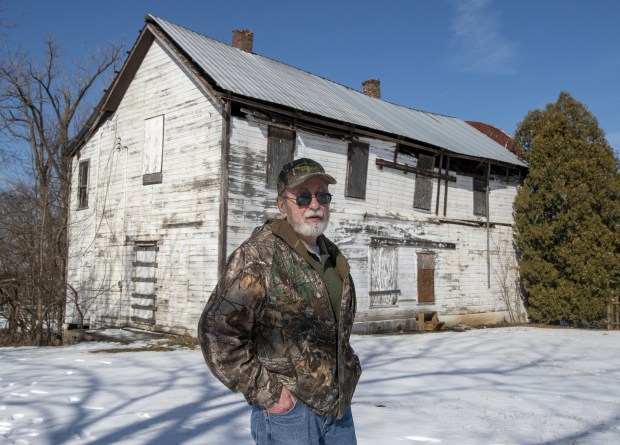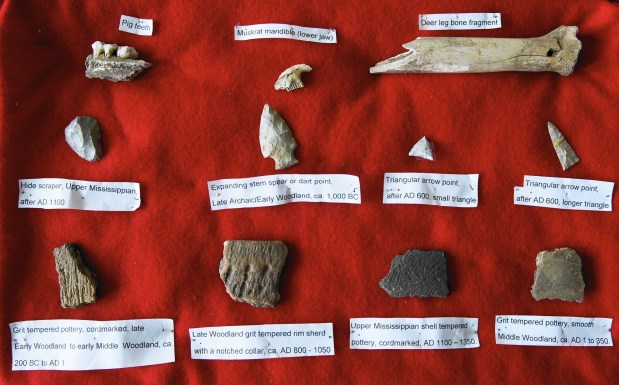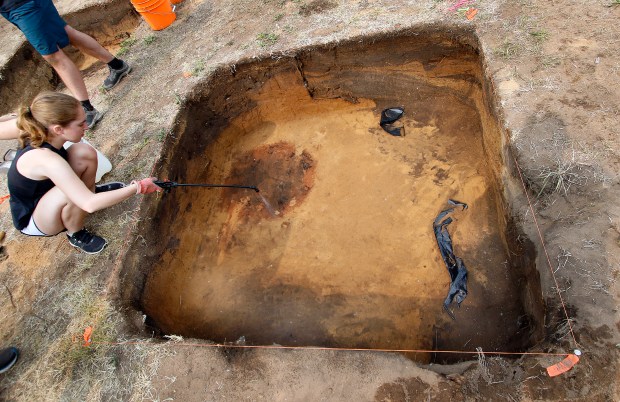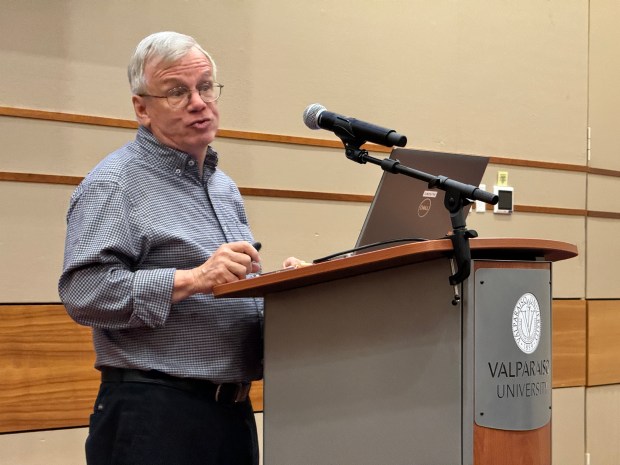New archaeological techniques are being used to analyze artifacts uncovered during digs at the Collier Lodge site along the Kankakee River.
Mark Schurr, an anthropology professor at the University of Notre Dame, has led excavations at the site for 20 years. He spoke Tuesday night at Valparaiso University to members of the Archaeological Institute of America.
Schurr plans another excavation from June 4 to June 20. Volunteers can sign up through the Kankakee Valley Historical Society website.
Part of what makes the Collier Lodge site on Baums Bridge Road so interesting is that it has been used for so long.
“In Indiana, it probably is one that one of the few sites that has almost every time period represented,” Schurr said. “There are few sites with this many different time periods present.”
Before the 1900s, when the Kankakee River was channelized and straightened, the Grand Kankakee Marsh covered the area. Where Collier Lodge stood until recently was one of the few places to cross the marsh. The closest places were in LaPorte County and Illinois.
“We’re on a continental divide here with a lot of traffic here over time,” Schurr said.
“For 10,000 years, people have been visiting this site. As they crossed the marsh, they would stop and camp there, and they would live there for a bit, and they leave their garbage behind,” he said.
Schurr first was interested in the site to see if it could have been a village for the people who built mounds in the area. That’s the only time period not represented in artifacts found there, however.
Nor is it easy to figure out which prehistoric artifacts belong to which tribe. “For most of the 1600s, the Iroquois were invading northern Indiana and actually made the area pretty much unhabitable,” Schurr said. “Everybody left and fled to the far side of Lake Michigan. In the early 1700s, people started to come back in, and when they came back in it seems like they kind of reshuffled themselves so that kind of breaks the link.”
Collier Lodge, which was so dilapidated it had to be razed, was built in 1898 as a hunting lodge. Beginning in the 1880s, hunt clubs formed and attracted hunters from far and wide. That all ended by 1922 when the last of the marsh was drained to create farmland.
The building then served as a general store and a private residence. After Jim Collier died in 1952, it was owned by others until the Kankakee Valley Historical Society formed by John Hodson took it over. Hodson owns surrounding acreage.
“I was always kind of afraid to work right by it, where it’s going to fall over on me,” Schurr said.
Because of modern zoning laws, a building can’t be put on the exact site today, but Schurr and Hodson hope a replica can be built a bit farther from the road to serve as a museum.

Kankakee Valley Historical Society president John Hudson stands outside the soon to be destructed and reconstructed Collier Lodge in Kouts, Indiana Monday Feb. 21, 2022. “It’s like the final pages of a story that started in 1898,” Hudson, who owns the lodge and surrounding 160 acres, says of plans to rebuild the lodge at a nearby location. (Andy Lavalley for the Post-Tribune)
Interesting finds
The oldest artifact found there is a spear point that dates to around 9,000 to 9,500 BC.
Because the site has been in use for so long, some of the artifacts are scrambled. For example, a prehistoric roasting pit likely was reused later. Historic artifacts have been mixed in with prehistoric finds.
“Here we have probably 600 years of archaeology in a space that’s 6 feet wide and 3 feet deep and about 3 feet wide and 3 feet deep, so untangling this stuff is always a big issue for us to try to figure out what the heck we’re looking at,” Schurr said.
“One year we worked there – remember we started in 2004 – we started finding coins that people lost at the site,” he said. “We were working at the site and we left our own archaeology behind.”
Among the interesting artifacts found there are pieces of copper and brass. Figuring out which isn’t easy.

A few of the thousands of artifacts found near Collier Lodge, some thousands of years old, near Kouts, IN., on Friday, May 20, 2016. The Kankakee Valley Historical Society has been working for several years to restore Collier Lodge. (Post-Tribune file)
“Native copper was used from thousands of years ago up until it was replaced by copper from Europe in 1580,” Schurr said. “On the coast of Canada, the Native Americans start trading with Basque and Norman fishermen from France and one thing they trade with them are copper kettles, pots made out of smelted copper.”
Native copper is super pure; the smelted copper that comes in has traces of other metals.
Brass kettles brought in by French trappers and traders were cheaper and a little flashier, and the Native Americans began using them, Schurr said.
“They had perfectly good native pottery they’re perfectly happy with, but they like to make ornaments and metal arrowheads and things out of the smelted copper,” he said. “And then the brass comes in and then after 1675 silver gradually starts to replace brass as important for trade ornaments.”
New techniques
In the field, those artifacts are usually corroded, so identifying them isn’t easy. Artifacts found at the site are analyzed afterward at Notre Dame.
X-ray fluorescence can be used to determine the chemical composition of the metal. That shows whether it’s brass, smelted copper or native copper.
Only within the last 10 years have archaeologists begun using that technology to analyze metals, Schurr said.
“We have lots of artifacts. Who knows what people will learn from studying those in the future, hopefully far, far into the future?”
Schurr is also interested in analyzing mussel shells found at the site for a new field of study that has only been in the last 20 years or so.
Sophie Chorek of Fairfield, Connecticut, sprays water into an excavated pit to darken the color. A roasting food pit can be seen in the left top corner during the last day of a two-week archaeological dig at the Collier Lodge site in Kouts. Volunteers and Notre Dame personnel work at the site on Thursday, June 15, 2023. (John Smierciak/Post-Tribune)
By studying the chemical composition of mussel shells, archaeologists can learn a lot about the climate at the time. The type of oxygen found in shells indicates whether it was warmer or colder.
During the Middle Ages in Europe, the climate was somewhat warmer than today. The Little Ice Age, as it’s called, lasted from about 1400 to about 1850. So when the first Europeans and later American colonists arrived in Northwest Indiana, it was colder than now.
“Sometimes we find a pit with mussel shells and it’s got pottery from the 1820s with it, so we could date those shells pretty precisely, or we could find the shells in the Upper Mississippian roasting pit that dates to about 1475,” Schurr explained. Small bits of shell – about the size of a grain of rice – are enough to analyze the oxygen isotopes in the shell.
“We could see during the Little Ice Age that the oxygen isotopes are much higher on the average and then they go down as the climate has become warmer,” Schurr said. “That gives us some sense about what people might have been facing.”
“They were able to colonize and live quite well in this environment even in a climate we would find somewhat more adverse than at present. We also think it was probably drier somewhat back then,” he said. “That would have changed the marsh productivity and maybe that was a reason why people settled at Collier Lodge.”
Marshes seasonally cycle between a lot of water and then more drying, so you get high biological productivity and a lot of diversity of plants and animals. Paradoxically, being in a colder and drier climate might have actually been better for living off the land, Schurr said.
Schurr encourages people to volunteer to help with this year’s excavation. Visitors are welcome, too, when workers are onsite.
“There’s very few places that you could come out and actually do and see archaeology happening that relates to your own county,” Schurr said.
Doug Ross is a freelance reporter for the Post-Tribune.




